Your bike has a dead battery. But you have a car charger.
Can you charge a motorcycle battery with a car charger?
You can charge a motorcycle battery with a car charger if the charger has a low charging rate (less than 2 Amp). In addition, the voltage specification of the battery and the charger must match (usually 12V).
Overcharging is also a major concern when you charge a motorcycle battery with a car charger.
Many modern car battery chargers come with various options to switch between different charging times and voltages.
I own one of these smart automotive chargers.
With these chargers, you can charge a lot of automotive batteries. Not just motorcycles.
Charging a motorcycle battery with a car charger
A motorcycle battery can be charged with a car charger even though the motorcycle manufacturers advise against it.

The only conditions are:
- Voltage condition: The voltage specification of both the charger and the battery should be the same. Usually around 12 Volts.
- Charging rate condition: Since motorcycle batteries have low capacities (4Ah to 12Ah), the car charger must have a low charging rate (less than 2 Amp).
Only if both these conditions are satisfied, you can charge the motorcycle battery with the car charger.
Typically, the voltage and capacity requirements are easily met.
So you should be able to charge a bike battery with a car charger.

The only exceptions are:
- If the motorcycle is an old model with an old battery of 6V
- The car chargers are 10, 20, or 30 Amp chargers. The charging rate is too high for motorcycle batteries.
Apart from these two exceptions, you can charge the motorcycle battery with a car charger.
Overcharging is a concern
You can charge a motorcycle battery with a car charger. But you must be careful not to overcharge.
Many modern motorcycles have maintenance-free batteries nowadays.
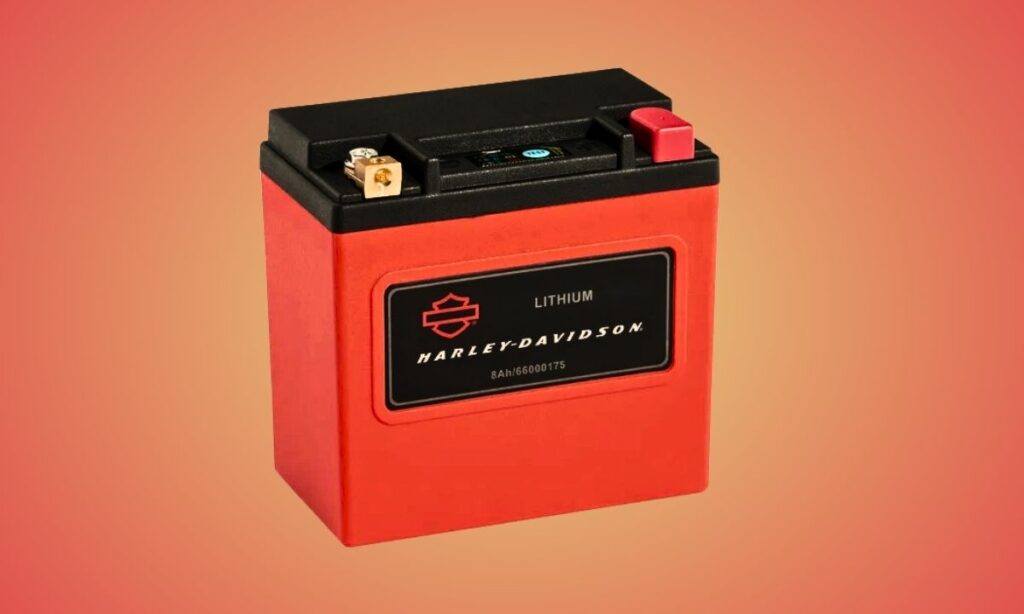
These batteries are sealed.
And overcharging is a bigger issue when you are charging these batteries with a car charger.
If you indeed overcharge, the motorcycle battery most likely will get damaged.
Overcharging is a concern when you charge a motorcycle battery with a car battery. Especially for maintenance-free batteries.
So be extra careful if you are dealing with a maintenance-free battery.
Can you also charge a car battery with a motorcycle charger?
A car battery can be charged with a motorcycle charger. Provided, the car battery’s amp-hour rating can be handled by the motorcycle charger.

A typical battery charger or a tender can handle battery capacities of 6 to 45 Ah.
The car battery amp-hour rating should fall within that range.

If the car battery has a capacity of 40Ah. The motorcycle charger can charge it.
But if the car battery has a capacity of 70Ah, you should not use the motorcycle charger to charge.
Checking the specifications of motorcycle battery and car charger
Let’s go through the prerequisite steps you must follow before using a car charger on a motorcycle battery.
#1. The battery voltage and the charger voltage must be the same
Modern motorcycle batteries operate at a 12 Volts DC.

And most car chargers are 12 Volts as well.
This should not be a problem in most cases.
Except for some old motorcycles that have batteries at 6 Volts.
Even then, many car battery chargers come with a setting to switch between 6V and 12V. You should be fine here.
#2. The car charger’s charging rate must be low
This is the deal breaker.
Most motorcycle batteries have capacities (amp-hour ratings) ranging from 4 Ah to 12 Ah.

In fact, most batteries on motorcycles have either 6 Ah or 8 Ah capacities.
However, car chargers usually are higher amp chargers.
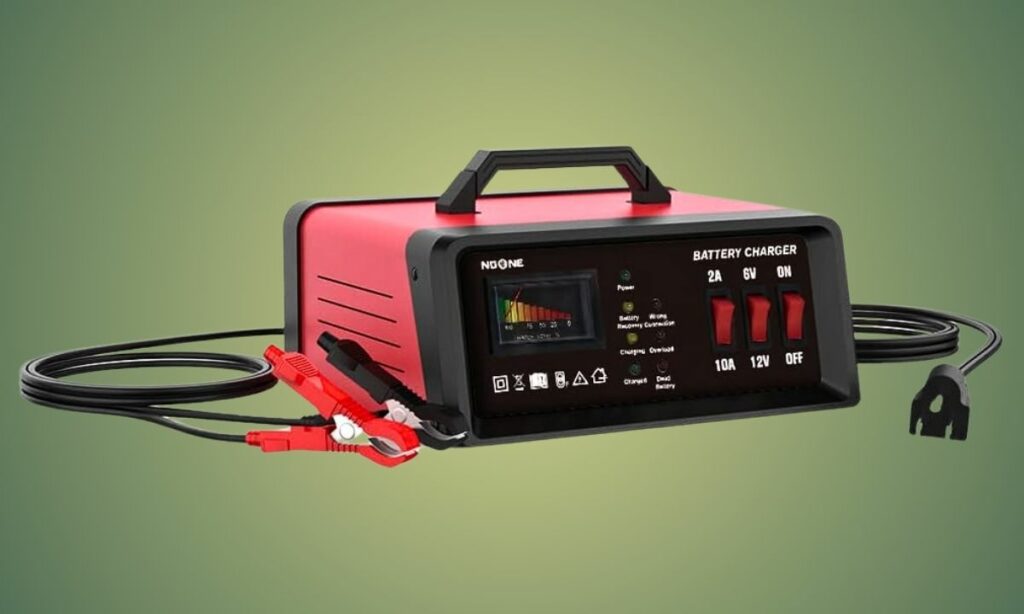
If the car chargers are 15, 20, or 30 Amp chargers, then they are not compatible. You must NOT charge a motorcycle battery with these car chargers.
On the other hand, if the car charger is a 1 or 2 Amp charger, then you can go ahead and charge your motorcycle battery.
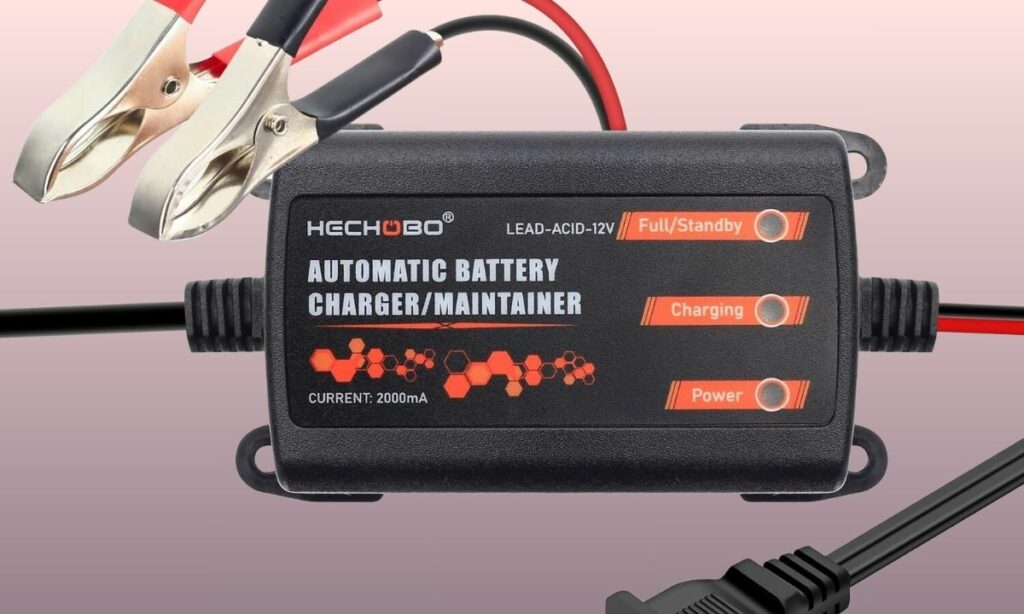
Many modern chargers have the option to change the charging rate.
If your car charger has that flexible option, then great. You can go ahead and charge.
How to charge a motorcycle battery with a car charger?
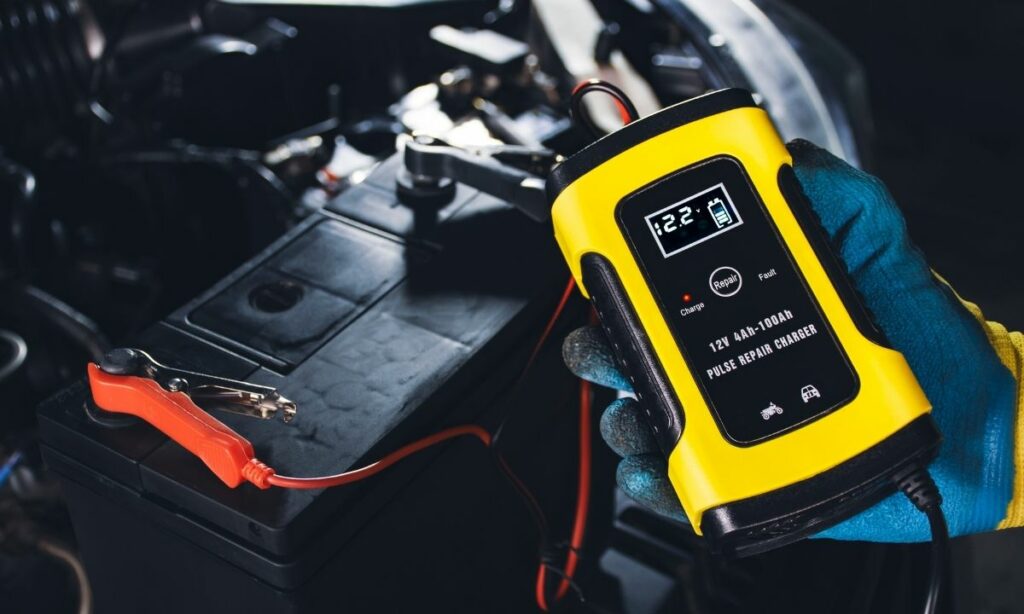
The steps to charge are the same as what you do with a normal charger. The instructions include:
- Put on appropriate safety gear.
- Remove the battery if you have to.
- Remove the ground cable from the battery and clean the terminal.
- If the battery is not maintenance-free, check the water levels. If low, pour distilled water.
- Now, take the charger out and make sure it is off.
- Connect the negative cable of the charger with negative terminal of the battery and the same for positive cable and positive terminal.
- Set the charger to the appropriate charging rate. Since it is a car charger for a motorcycle battery, set the charge rate to 1 amp preferably.
- Switch on the charger and set the timer.
- Once charged, turn off the charger first before disconnecting the cables.
How long does it take to charge?
Short answer. The motorcycle battery takes around 8 to 12 hours to charge.
Long answer. It depends. A lot of factors decide the charging time of a motorcycle battery.
These factors include:
- Battery type
- Charging rate
- Battery capacity
- Battery condition

Since we are using a car battery charger to charge the motorcycle battery here, the charging time is the main factor here.
The difference between 1 Amp charging time and 2 Amp charging time will be a lot different.
Relationship Between Charging Time And Charging Current
The charging time of the battery is dependent on two factors – i) Battery Capacity; and ii) Charging Current.
The relationship is best defined as:
Charging time of the battery = Battery Capacity / Charging Current
The units corresponding to each unit are:
- Charging time in Hours (Hrs)
- Battery Capacity in Ampere-hour rating of the battery (Ah)
- Charging Current expressed in Amperes (A)
In an ideal scenario, the equation holds good.
But in real scenarios, there will be losses and leakage in the charging. Which pushes the charging time even higher.
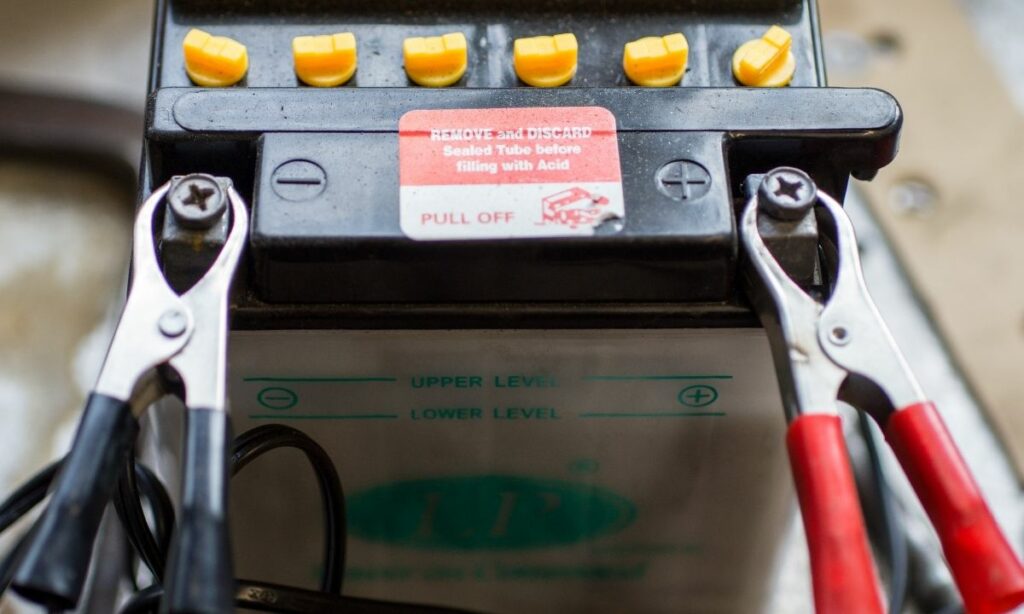
Suppose the battery capacity has an ampere-hour rating of 12 Ah. And let the charging be happening at 2 amps. The leakage is 40%.
Then,
Charging Time = (12 Ah * 1.4) / 2 A = 8.4 Hrs.
Summing up
- You can charge a motorcycle battery with a car charger. The voltage must match. And the car charger must have a low charging rate (preferably less than 2 Amps).
- Similarly, you can charge a car battery with a motorcycle charger as well. The car battery amp-hour rating should fall within the charger’s range.
- Overcharging is a concern when you charge a bike battery with a car charger. The battery can get damaged if overcharged.
- Always ensure the voltage matches between the charger and the battery. Usually, it’s 12V.
- Make sure the car charger’s amperage is low. Since motorcycle batteries have 4Ah to 12Ah capacities, the charger’s amperage should be lower than 2A.
- Wear appropriate gear while charging the battery.
- The charging time depends on battery type, capacity, condition, and the charging current. But in a typical case, the charging time will be around 8 to 12 hours.
Before you go…
Here are a few more battery related posst for you:
